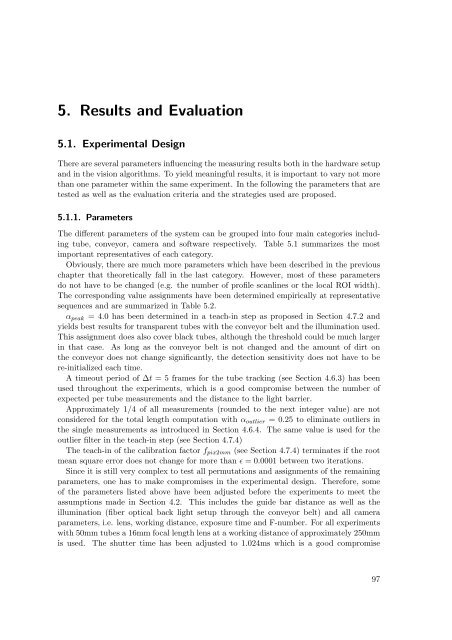Master Thesis - Fachbereich Informatik
Master Thesis - Fachbereich Informatik
Master Thesis - Fachbereich Informatik
Create successful ePaper yourself
Turn your PDF publications into a flip-book with our unique Google optimized e-Paper software.
5. Results and Evaluation<br />
5.1. Experimental Design<br />
There are several parameters influencing the measuring results both in the hardware setup<br />
and in the vision algorithms. To yield meaningful results, it is important to vary not more<br />
than one parameter within the same experiment. In the following the parameters that are<br />
tested as well as the evaluation criteria and the strategies used are proposed.<br />
5.1.1. Parameters<br />
The different parameters of the system can be grouped into four main categories including<br />
tube, conveyor, camera and software respectively. Table 5.1 summarizes the most<br />
important representatives of each category.<br />
Obviously, there are much more parameters which have been described in the previous<br />
chapter that theoretically fall in the last category. However, most of these parameters<br />
do not have to be changed (e.g. the number of profile scanlines or the local ROI width).<br />
The corresponding value assignments have been determined empirically at representative<br />
sequences and are summarized in Table 5.2.<br />
αpeak =4.0 has been determined in a teach-in step as proposed in Section 4.7.2 and<br />
yields best results for transparent tubes with the conveyor belt and the illumination used.<br />
This assignment does also cover black tubes, although the threshold could be much larger<br />
in that case. As long as the conveyor belt is not changed and the amount of dirt on<br />
the conveyor does not change significantly, the detection sensitivity does not have to be<br />
re-initialized each time.<br />
A timeout period of ∆t = 5 frames for the tube tracking (see Section 4.6.3) has been<br />
used throughout the experiments, which is a good compromise between the number of<br />
expected per tube measurements and the distance to the light barrier.<br />
Approximately 1/4 of all measurements (rounded to the next integer value) are not<br />
considered for the total length computation with αoutlier =0.25 to eliminate outliers in<br />
the single measurements as introduced in Section 4.6.4. The same value is used for the<br />
outlier filter in the teach-in step (see Section 4.7.4)<br />
The teach-in of the calibration factor fpix2mm (see Section 4.7.4) terminates if the root<br />
mean square error does not change for more than ɛ =0.0001 between two iterations.<br />
Since it is still very complex to test all permutations and assignments of the remaining<br />
parameters, one has to make compromises in the experimental design. Therefore, some<br />
of the parameters listed above have been adjusted before the experiments to meet the<br />
assumptions made in Section 4.2. This includes the guide bar distance as well as the<br />
illumination (fiber optical back light setup through the conveyor belt) and all camera<br />
parameters, i.e. lens, working distance, exposure time and F-number. For all experiments<br />
with 50mm tubes a 16mm focal length lens at a working distance of approximately 250mm<br />
is used. The shutter time has been adjusted to 1.024ms which is a good compromise<br />
97














